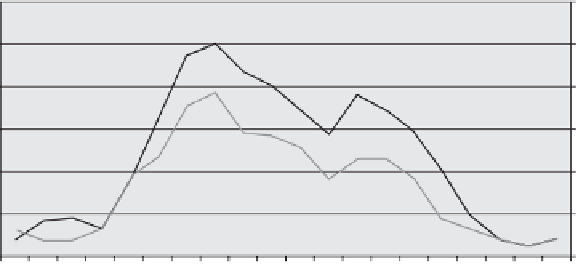Geoscience Reference
In-Depth Information
FIGURE 5.2. Evolution of the Unemployment Rate in Canada and the United States
(1926-1945)
Issues of comparability aside, the trend shown by these indicators is similar
in both countries. The peak in the unemployment rate is 1931,with19.32%
of the civilian labor force in Canada
5
and around 24% in the United States.
Likewise, the GNP per capita hit the floor during the period 1930-1931 in both
nations. Talking about the United States, Achembaum (
1986
: 16-17) offers the
following picture of the Depression's implications:
[ . . . ] this time the extent, intensity, and duration of the upheaval were unprecedented.
Between October 1929 and June 1932, the common stock price index dropped from
260 to 90. The nation's real GNP, which had risen 22 percent between 1923 and 1929,
fell 30.4 percent over the next four years. Nearly 5,000 banks, with deposits exceeding
$3.2 billion, became insolvent; 90,000 businesses failed. The gross income realized
by farmers was cut nearly in half [ . . . ] More than one thousand local governments
defaulted on their bonds [ . . . ] Breadlines formed [ ...]Bankruptfirmscouldnothonor
their pensions obligations to superannuated workers. [ . . . ] Misery was a threat to
everyone.
The picture looked no better in Canada (Struthers
1983
: 44-104). The Royal
Commission on Dominion-Provincial Relations put it blatantly when stating
that “the livelihood for hundreds of thousands of citizens seemed to be entirely
dependent upon public charity” (1940: 162). Along with its widespread scope,
the Depression also had a geographical dimension.
Figure 5.3
illuminates this
dimension by mapping the distribution of states and provinces along three
variables: the level of regional income per capita at the beginning of the crisis
5
Guest (
1997
: 83) offers estimates that put Canada closer to the US: “At the bottom of the
Depression in 1933 nearly one quarter of the labor force was out of work and seeking jobs and
an estimated 15 percent of the population was in receipt of relief.”


